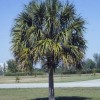Resumen
The sabal palm, or cabbage palm, is native to Florida and coastal regions of North and South Carolina and Georgia and is the state tree of both South Carolina and Florida. The name “cabbage palm” comes from its edible immature leaves, or “heart,” which has a cabbage-like flavor. This 5-page fact sheet was written by T. K. Broschat, and published by the UF Department of Environmental Horticulture, July 2013.
Citas
Broschat, T. K. 1991. "Effects of Leaf Removal on Survival of Transplanted Sabal Palms." J. Arboriculture 17: 32-33.
Broschat, T. K., and H. Donselman. 1984. "Root Regeneration in Transplanted Palms." Principes 28: 90-91.
Carpenter, W. J. 1987. "Temperature and Imbibitions Effects on Seed Germination of Sabal palmetto and Serenoa repens." HortScience 22: 660.
McPherson, K., and K. Williams. 1996. "Establishment Growth of Cabbage Palm, Sabal palmetto (Arecaceae)." Amer. J. Bot. 83: 1566-1570. https://doi.org/10.1002/j.1537-2197.1996.tb12814.x
Meerow, A. W. 2006. Betrock's Landscape Palms. Hollywood, FL: Betrock Information Systems.
Sento, T. 1970. "Studies on the Germination of Seed of the Palms. II. On the Livistona chinensis (R. Brown), Phoenix roebelenii (O'Brien), and Sabal Species." J. Jap. Soc. Hort. Sci. 39: 261-268. https://doi.org/10.2503/jjshs.39.261
Unless otherwise specified, articles published in the EDIS journal after January 1, 2024 are licensed under a Creative Commons Attribution-NonCommercial-NoDerivs 4.0 International (CC BY-NC-ND 4.0) license.

